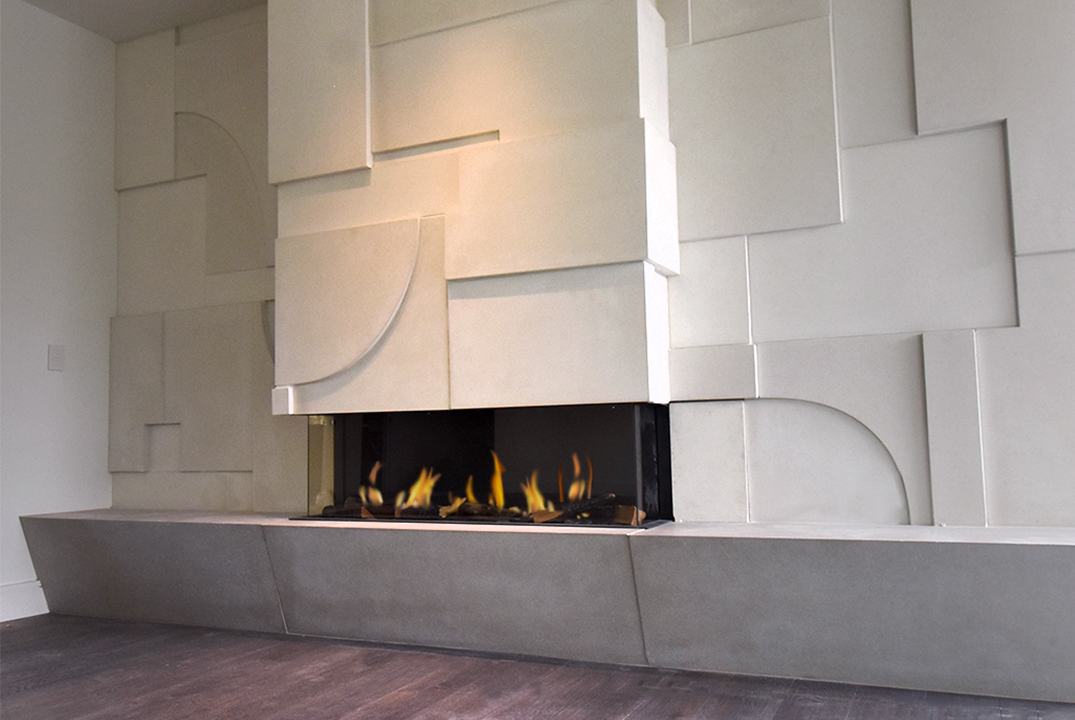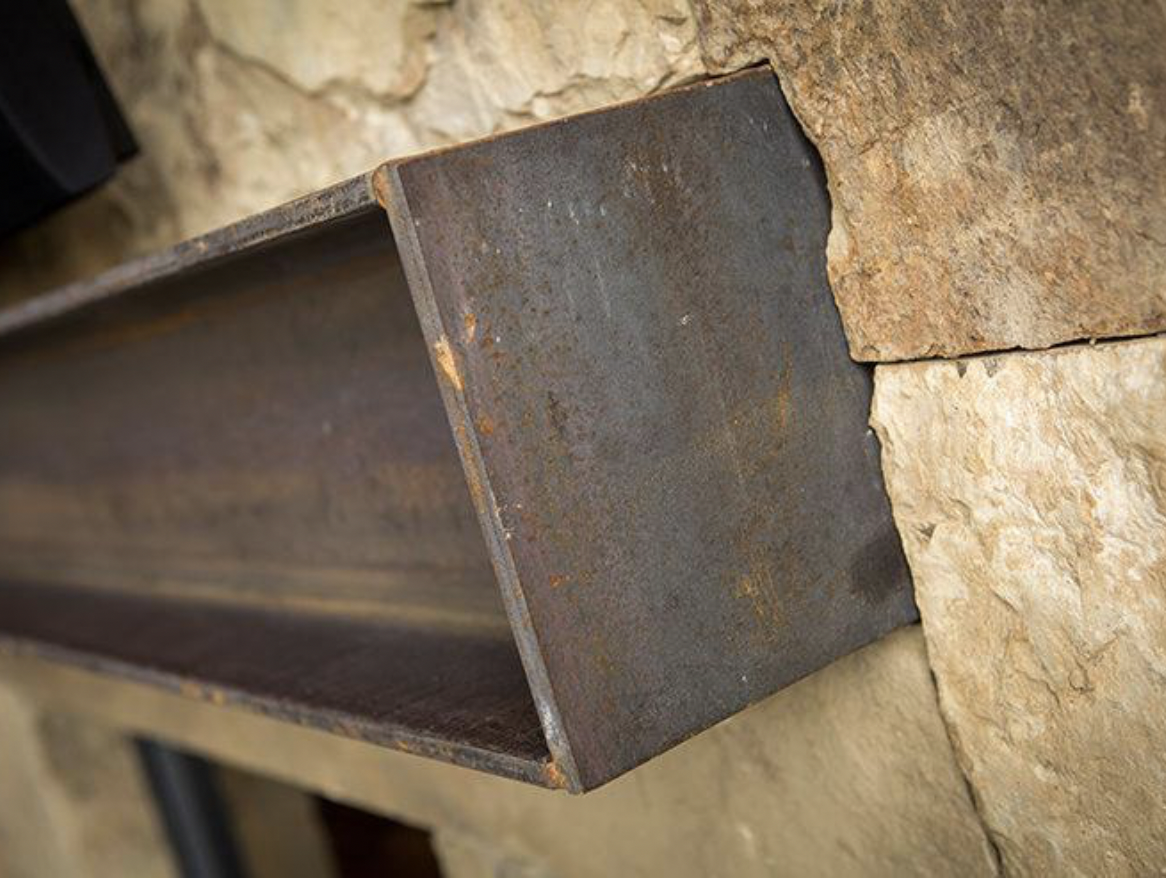
YESTERDAY: Some gas fireplace manufacturers still offer doors and louvers, but the trend is towards clean lines and surrounds that make a sophisticated design statement. Photo credit: Charles DeluvioSince the advent of direct vent technology in the 1980s, gas fireplaces and their accompanying surrounds have gone through a number of design trends. In their early years, the factory-made surrounds that attached to the fireplace tended to consist of bulky black-painted raised panels and trims, decorative and functional knobs, louvers top and bottom as well as screened doors.
Usually, these clumsy adornments were intended to cover up the more functional and mechanical parts of the fireplace. Genuine aesthetic considerations came secondary.
Planning a fireplace project?

In the past, traditional fireplace designs often incorporated chunky black frames, a stone hearth surround, and a wooden mantel above. Photo credit: James DeMers
Early fireplace design usually followed a pretty standard formula: fireplace + mantel + hearth surround. In many regions of the country, this was most often a complete surround consisting of a wood mantel above and brick or stone on the sides. The occasional tile hearth surround – usually Delft blue – would dare to be different. Other parts of the country would feature their own regional influences, be it adobe-style in the Southwest or terra cotta in California. The universal theme, however, was an allegiance to tradition.

Delft tile often adorned traditionally inspired fireplace surrounds. Photo via Pixabay.
Design tastes change, however, and are not set in stone. The showy excess of the 80’s has given way to a simpler, more minimalist aesthetic. The spare elegance of Scandinavian design, for example, and its reliance on rich, natural materials, has gradually made its way across the Atlantic to North American shores.
Fireplace manufacturers like European Home and English designer Gavin Scott have introduced this style to the North American fireplace market. Their Vision model designed in 2004, for example, was one of the first clean-faced gas fireplaces to showcase this striking design transition.
Simplicity carried to an extreme, becomes elegance.
– John Franklin

Vision Fireplace by European Home, one of the vanguard models of the clean-face gas fireplace aesthetic. Still stunning today, it features optional stainless steel or concrete surround available in many colors (white concrete surround pictured here).
The Clean Face Fireplace: An Open Canvas
Today there is a continued demand by consumers to see more of the fire and less of the steel appliance that contains the fire. Clean face, modern gas fireplaces with their advanced flame technology, and variety of natural fire media like logs, stones, and glass have become ubiquitous in new construction in the U.S.
This doesn’t mean, however, that modern gas fireplaces are always meant to stand alone. Far from it! Given that they’re invariably the focal point of any room they inhabit, modern fireplaces offer a striking foundation for inventive fireplace surrounds. Contemporary surrounds can be made from a variety of rich materials, offer textural compliments to your fire and offer the opportunity to make bold design statements.

H Series See-Through Fireplace featuring a designer surround of marble tile and gold.
Want help designing your fireplace surround?
Fireplace Surrounds from the Industrial Designer’s Perspective
Architects and interior designers put a lot of thought into developing a cohesive vision for their projects. Symmetry, composition, balance, and hierarchy are important to both because these guidelines are the foundational bedrock of good design.
Architizer, an online design/build resource for architects, recognizes how fireplaces fit into that overall design picture, saying “modern-day fireplaces have transformed from a thing of necessity into one of visual interest and technological wonder.”
One notable contributor to creating fireplace surrounds that span the spectrum of styles is Denver-based Distinctive Mantel Designs. Owner and designer, Eric Walden says the company still has strong pockets of clients – particularly in the Northeast – that prefer Old World and traditional styles, but there’s a distinct trend towards modern and contemporary design.

Distinctive Mantel Designs’ custom-built geometric concrete design frames a Trisore 140 fireplace by Element4. Interior Designer: Collin Griffith
“Most of our work is transitional. I think that more people are into modern design, but they’re not content to just put in a linear box and be happy with it” he pointed out. “The clean-face fireplace is definitely here to stay though. But maybe it’s square instead of linear, with a blend of materials and a unique fireplace surround look. People are trying to create something different.”
The company produces cast concrete and wood mantels and surrounds that they are able to ship nationwide. For its custom installations in Colorado, Walden collaborates with designers who incorporate concrete, wood, and patina-finished metals into their custom fireplace projects.
Even as design trends continue to evolve, Walden claims there is one absolute that stubbornly remains. “There are still lots of fireplace manufacturers that use engineers to design their products. They should be using industrial designers who know the importance of design and aesthetics.”
An Interior Designer Weighs In
Corinna Haimerl, a German interior designer living in London, Ontario in Canada studied interior architecture and architectural design at the University of Colburg in Germany. The principal owner of BlueSky Interior Design, she is an unabashed fireplace lover.
“Anytime I have a project that includes a fireplace I think of the fireplace as the main focus. It’s the heart of the house. So that’s where I start my design and I work out from there,” she says.

An industrial I-beam mantel is a contemporary example of how designers are complementing clean face gas fireplaces. Design by Eric Walden.
Corinna works with clients all over North America. She says she is also seeing a gradual shift towards a more modern, less traditional aesthetic.
“There are clients set on traditional design and if that’s what they want, that’s fine. But many more are seeing modern design in places like Pinterest and they are open to the suggestion. There’s always a way to encourage them in that direction,” she explains.
The clean, unadorned lines of a modern fireplace make a perfect drawing board for designers and their clients to draw up ideas. Whether it’s creating depth with contrasting textures like patina-finished metal, Italian tile, colored concrete, or strong geometric lines with offset panels, today’s fireplace surrounds offer many unique choices.

Want to leave your fireplace design to the professionals? Some fireplace suites, such as this Compton 1000 electric fireplace, come standard with their own prefabricated modern surround, eliminating the need for further design decisions. Simply hang on a wall, plug in and enjoy!
Learn more about fireplace manufacturer, European Home, and our line of distinctive modern gas, electric, and wood fireplaces, or find an authorized fireplace dealer in your area.

Robert Conlin is a freelance writer living in Wiscasset, Maine. A former certified chimney sweep and retail stove shop owner, he has returned to his roots as a journalist/writer in producing enterprise reporting and online content for a variety of publications and companies.

Disqus comments will appear here